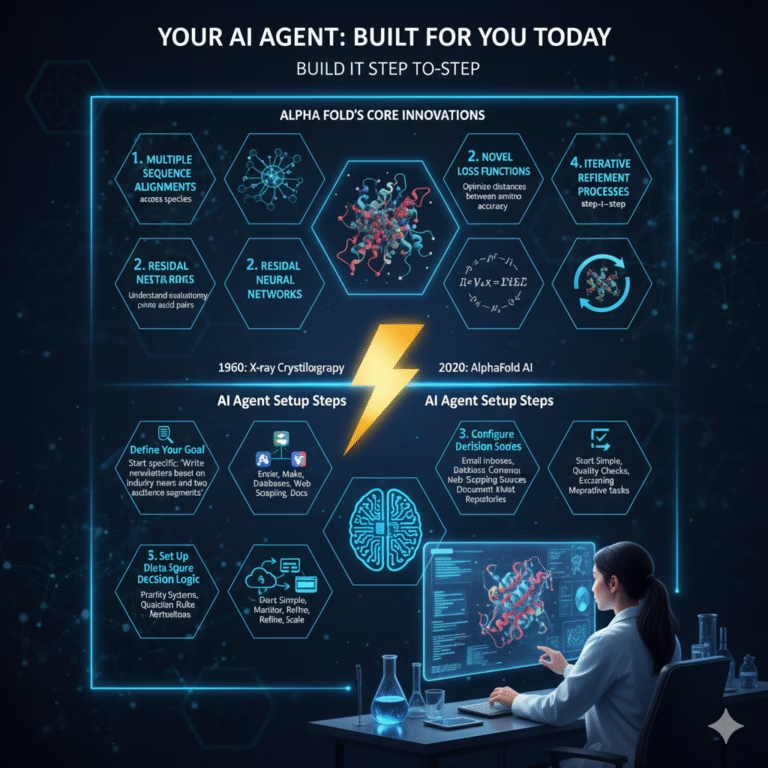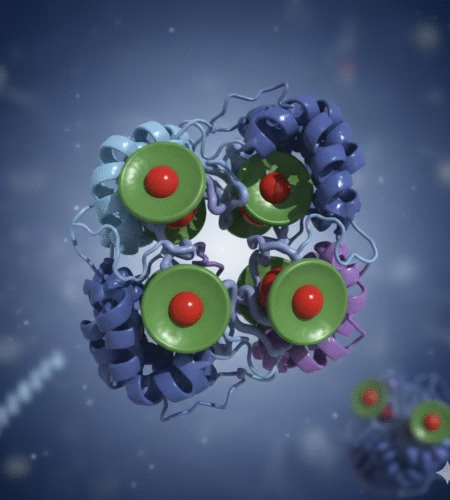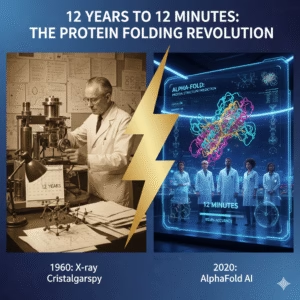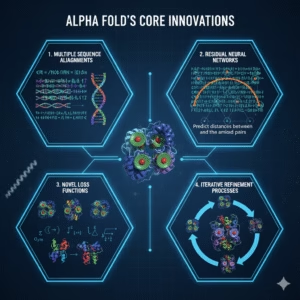12 to 12: AI’s Breakthrough
Imagine dedicating over a decade of your life to a single scientific puzzle. In the 1960s, that was the reality for John Kendrew. He spent twelve painstaking years working out the first protein structure. He relied on X-ray crystallography, intricate hand-drawn sketches, and endless, meticulous calculations. Each new data point meant another late night of checking numbers on paper. When he finally revealed the structure of myoglobin, the scientific world erupted in celebration—it was a monumental achievement—but progress in the field remained painfully, glacially slow. By the early 1970s, fewer than 100 proteins had been mapped.
Fast forward to 2020. A new era dawned when DeepMind’s AlphaFold arrived, predicting protein structures in mere minutes, with near-atomic accuracy. A task that once consumed a scientist’s entire career could now be accomplished before lunch. “It was like having a telescope for the molecular world,” one researcher famously said, capturing the awe and transformative power of this breakthrough
Why Proteins Matter….
Proteins truly are the intricate machinery of life. Their specific three-dimensional shapes determine how cells function, how diseases spread their insidious grip, and how vital drugs interact with our bodies. When these tiny biological marvels fold incorrectly, the results can be devastating; conditions like Alzheimer’s, Parkinson’s, and cystic fibrosis are all tragically linked to misfolded proteins.
With AlphaFold, researchers suddenly gained an incredibly powerful shortcut. Instead of waiting years for arduous lab results, drug developers can now model proteins with unprecedented speed on their laptops. Environmental scientists are actively testing enzymes specifically designed to break down persistent plastics, tackling a global challenge. Even vaccine developers can simulate viral proteins within days of a new outbreak, dramatically accelerating our response to emerging threats. What was once rare, expensive, and time-consuming knowledge is now accessible almost on demand, democratizing discovery.
Recognition and Ripple Effects
The sheer magnitude of AlphaFold’s impact didn’t go unnoticed. In 2024, the Nobel Committee awarded Demis Hassabis and John Jumper the prestigious Chemistry Prize for their groundbreaking work, describing it as “a fundamental shift in how biology is done.” This recognition was more than just scientific prestige; it served as a powerful confirmation that AI had decisively moved from a realm of abstract promise to one of tangible, revolutionary practice, fundamentally changing the rules of scientific research forever.
But the ripple effects of this AI revolution don’t stop within the confines of a research lab. They are now extending into our offices, reshaping factory floors, and even optimizing processes on our farms. The intelligent machine that can decode life’s building blocks is now poised to transform our daily work and productivity in equally profound ways

Nano Manana…
The scientific breakthroughs like AlphaFold are just the beginning. In fact, a single week in the world of AI now brings a dizzying array of innovations, some whimsical, others profoundly practical. For instance, the concept of a “nano-Manana” ( a personal way of talking about AI in food systems) revolution: researchers using AI to assess banana ripeness with precision, allowing optimal harvest times and minimizing waste.
Globally, many countries are using AI-powered systems to optimize fruit harvesting. Companies like Tuba.AI have developed technology that classifies fruits, including bananas, into ripeness categories such as unripe, ripe, overripe, or rotten using real-time image analysis. These systems help farmers determine the best harvest times, streamline operations, and reduce food waste, marking a step forward in precision agriculture.
Meanwhile, back in the office, AI is quietly becoming the ultimate colleague. Tools like Claude are transforming the drudgery of data management and presentation creation into effortless tasks.
AI productivity tools have evolved far beyond simple text generation. Today, sophisticated assistants like Claude can directly create and edit Excel spreadsheets, craft documents, design PowerPoint slide decks, and even manage read through right from its interface.
ChatGPT’s Evolving Developer Module: Empowering Creation
OpenAI’s developer tools have similarly expanded far beyond basic API calls. Their platform now empowers users to create custom GPTs without writing a single line of code, enables powerful function calling for seamless external integrations, offers vision capabilities for advanced image analysis, and includes a robust code interpreter for complex data processing. The vibrant plugin ecosystem further provides specialized tasks and functionalities, allowing businesses to build sophisticated, AI-powered applications without requiring extensive technical expertise.

Making AI Work for You Today
The AI revolution is not just for research laboratories; it’s here, now, to boost our everyday productivity. Here’s how to start harnessing its power immediately:
You can upload your Excel files to Claude for instant analysis, use AI to create presentation templates that maintain brand consistency, set up simple automations for those repetitive tasks that eat away at your day, and even experiment with agents for basic data collection.
To build your expertise, practice prompt engineering for better results, learn basic workflow design principles to structure your AI interactions, understand when to strategically use agents versus simple automations, and consistently monitor AI output quality to ensure it meets your standards.
Looking ahead, it’s wise to identify which processes within your work or organization are most suitable for AI assistance, calculate the potential time savings from AI implementation, plan team training for new AI tools, and establish clear guidelines for ethical and effective AI use in your organization.
Beyond Proteins: AI’s Other Scientific Revolutions
AlphaFold represents just one spectacular breakthrough in AI’s broader scientific transformation. Other DeepMind and advanced AI systems are tackling equally complex problems across an astounding array of fields.
Weather Prediction: From Days to Weeks
Where traditional weather forecasts once struggled beyond a few days, AI is dramatically extending our vision. GraphCast is now the world’s most accurate 10-day global weather forecasting system, capable of predicting extreme weather events further into the future than ever before. DeepMind’s latest model, GenCast, predicts weather and the risks of extreme conditions with state-of-the-art accuracy, delivering forecasts up to 15 days ahead. This translates into tangible benefits: AI predicted Hurricane Maria’s path 9 days out, versus traditional models’ 5-day accuracy in 2017. For European windstorm forecasting, GenCast provides 80% accuracy at 7-day forecasts, a significant leap from traditional methods’ 65%. For renewable energy planning, wind farms are now using AI forecasts to optimize energy production schedules two weeks in advance.
Nuclear Fusion Control: Taming Plasma Chaos
One of humanity’s grandest scientific challenges is harnessing nuclear fusion, the energy that powers the sun. A major hurdle has been controlling superheated plasma within tokamak reactors, where instabilities can disrupt experiments. By using sophisticated reinforcement learning, scientists were able to predict plasma tearing in the DIII-D tokamak reactor. Princeton’s AI system now actively prevents plasma disruptions that previously destroyed fusion experiments. The DIII-D reactor’s AI predicts plasma instabilities a crucial 30 milliseconds before they occur, achieving a 95% prevention rate of disruptive events, compared to just 60% with human operators. Each prevented disruption saves approximately $50,000 in equipment damage and two weeks of costly repairs, accelerating our quest for clean energy.
Mathematical Breakthroughs: Olympiad-Level Problem Solving
Mathematics, often considered the pinnacle of human logical reasoning, is also seeing AI make astonishing progress. Google DeepMind announced AlphaGeometry, an AI system that solved complex geometry problems at a level approaching a human International Mathematical Olympiad gold-medalist. AlphaGeometry successfully solved 25 out of 30 geometry problems, a score remarkably close to the human gold medalist average of 25.9 out of 30 problems, and it did so in just 19 seconds per problem versus hours for human mathematicians. This capability has profound applications, from refining bridge design calculations and planning satellite trajectories to optimizing architectural load distribution.
Materials Discovery: From Theory to Reality
The search for new, revolutionary materials has historically been a painstaking process of trial and error. Now, AI systems are predicting material properties before synthesis, dramatically accelerating development timelines from years to mere months. Specific successes include AI identifying 32 new lithium-ion electrode materials in 2024, predicting perovskite structures that achieved 31.3% solar efficiency (surpassing the previous 29.1% record), and identifying 74 potential room-temperature superconducting compounds. This means material testing is being reduced from an average of 18 months to just 3 months, rapidly bringing innovations to market.
Climate Solutions: Measurable Environmental Impact
The search for new materials has historically been a slow, trial-and-error process, but AI is transforming this landscape by predicting material properties before synthesis, dramatically accelerating development timelines. In 2024, Microsoft and the Pacific Northwest National Laboratory used AI to screen over 32 million potential candidates, identifying 18 promising lithium-ion electrode materials in just 80 hours a process that would have taken decades using traditional methods . Similarly, researchers at the Karlsruhe Institute of Technology employed AI to discover new perovskite solar cell materials, achieving efficiencies of 26.2% with only 150 targeted experiments, reducing both time and cost compared to conventional approaches . AI has also been used to predict 74 potential room-temperature superconducting compounds, including candidates B5CN2 and B4CN3, marking a significant advancement in the quest for practical superconductors . Overall, these AI-driven approaches are reducing material testing timelines from an average of 18 months to just 3 months, rapidly bringing innovations to market.
The transformation from Kendrew’s 12-year protein structure endeavor to AlphaFold’s 12-minute prediction represents far more than just technological progress. It vividly demonstrates AI’s profound potential to accelerate human capability across every conceivable domain. Whether you’re predicting complex protein structures, asserting control over challenging nuclear fusion experiments, or simply streamlining your workday by creating Excel models and presentations, AI tools are increasingly handling the heavy lifting. This liberates you to focus on deeper insights, strategic thinking, and groundbreaking innovation.
The question is no longer if AI will change how you work, but rather, how quickly you will adapt to harness its immense power.
Class 101: Building Agents
Building your own agent can be surprisingly straightforward:
- Define Your Goal: Start with a specific, measurable objective. Instead of “help with marketing,” aim for “write weekly newsletter content based on industry news.”
- Choose Your Platform: Options range from visual interfaces like Zapier Central, which connects to over 5000 apps, to more advanced logic platforms like Make (formerly Integromat), or even custom code for maximum flexibility if you have programming skills.
- Set Up Data Sources: Connect your agent to the information it needs, whether it’s email inboxes, database connections, web scraping sources, or document repositories.
- Configure Decision Logic: This is where you program your agent’s reasoning, establishing priority systems for task management, quality checks for output validation, escalation rules for complex situations, and even learning mechanisms for continuous improvement.
- Test and Iterate: Begin with simple tasks, carefully monitor performance, adjust parameters based on results, and then gradually scale up its responsibilities.
The practical applications are endless: imagine a Customer Service Agent that monitors support tickets, responds to common questions, escalates complex issues to human colleagues, and even updates customer records automatically. Or a Content Creation Agent that scans industry news daily, generates article outlines, writes first drafts, and schedules social media posts. A Data Analysis Agent could collect sales data weekly, identify trends and anomalies, create summary reports, and send alerts for significant changes, freeing up human analysts for deeper insights.
Get the Lastest in Communication- Media and the Latest tools
Categorized in:
Subscribe to our email newsletter to get the latest posts delivered right to your email.



Hello my loved one I want to say that this post is amazing great written and include almost all significant infos I would like to look extra posts like this
Thank you for your kind comment, please do subscribe and keep reading